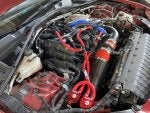Hello Alfa owners. Has anyone modified their pcv system to add oil separator?
Given the whole direct injected and carbon issues, thinking I will add to the separators to each pcv and breather. It looks straightforward, Ive done prior on my Mini Cooper track car. Just a shout out if any Alfa owners have any experiences with this? Here’s a simple schematic.
I’m concerned about one thing w this setup.
Using a check valve on the pcv circuit between intake and can seems to indicate once under boost, the little check Valve will take the brunt of the manifold pressure and seemingly preclude the much more robust factory pcv to do it’s job as it’s blocking pressure to the pcv. I guess you take the cv out but now separator gets pressurized.. don’t like that!! Could block off manifold and use vacuum from turbo inlet.
Any thoughts.
Given the whole direct injected and carbon issues, thinking I will add to the separators to each pcv and breather. It looks straightforward, Ive done prior on my Mini Cooper track car. Just a shout out if any Alfa owners have any experiences with this? Here’s a simple schematic.
I’m concerned about one thing w this setup.
Using a check valve on the pcv circuit between intake and can seems to indicate once under boost, the little check Valve will take the brunt of the manifold pressure and seemingly preclude the much more robust factory pcv to do it’s job as it’s blocking pressure to the pcv. I guess you take the cv out but now separator gets pressurized.. don’t like that!! Could block off manifold and use vacuum from turbo inlet.
Any thoughts.











